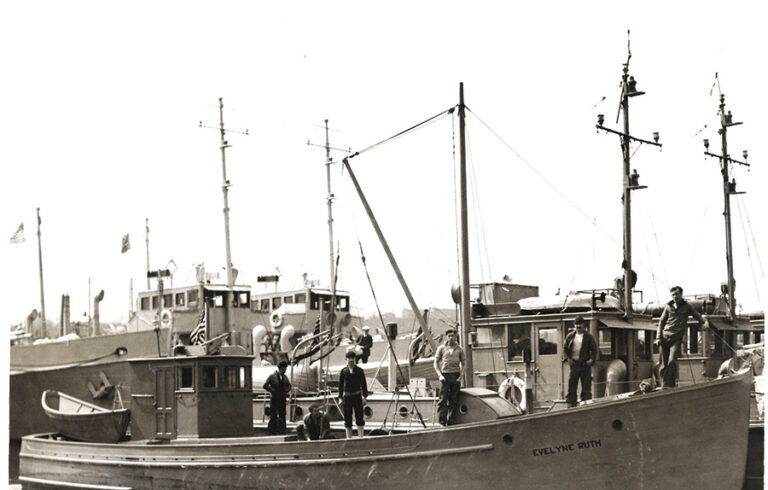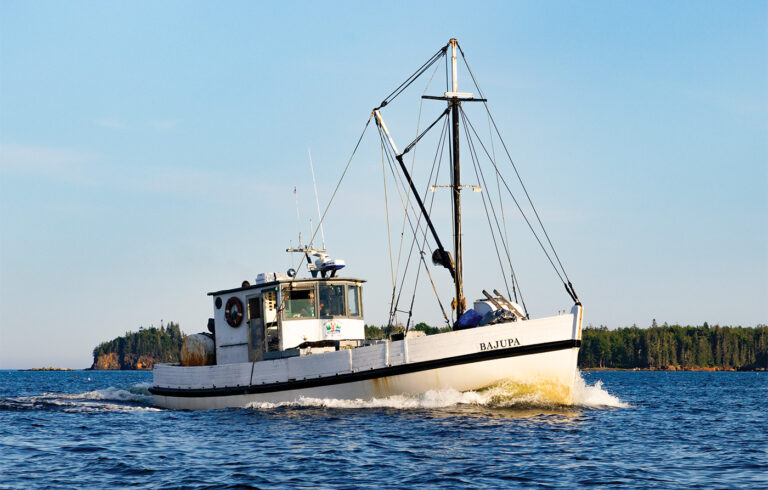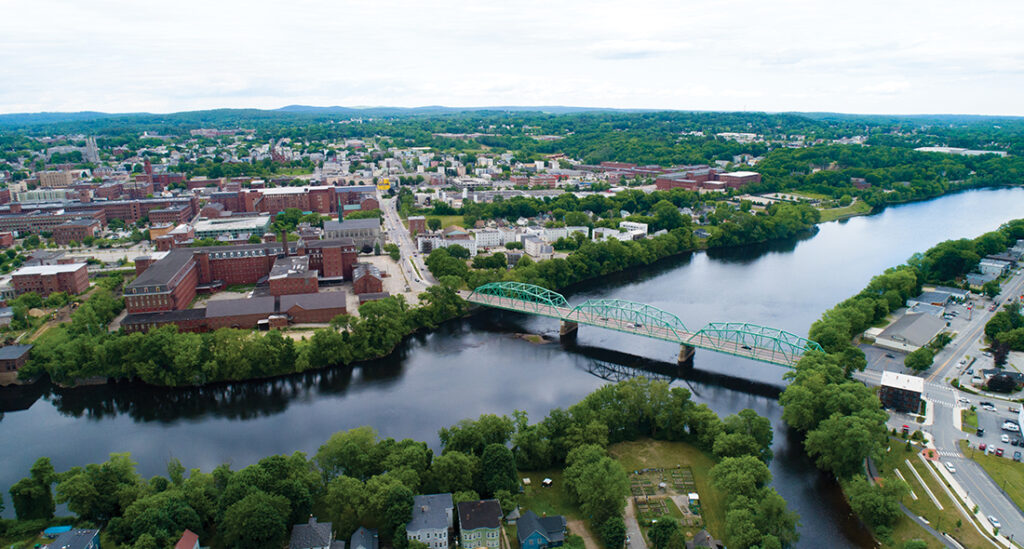
The site of the Continental Mill in Lewiston on the Androscoggin River as seen from Auburn, the western bank. Textile mills like the ones in Lewiston as well as paper mills upstream contributed significantly to the Androscoggin’s degradation in the 1950s and 60s.
PHOTO: JACK SULLIVAN
Fifty years ago, Maine Sen. Edmund Muskie concluded a decade-long fight to pass legislation to protect—and improve—the quality of the nation’s fresh and salt waters. Even though then-President Richard Nixon worked to stop the bill, on Oct. 18, 1972, the Clean Water Act became law.
Muskie (1914-1996), who grew up in Rumford on the banks of the Androscoggin River, had watched as the river slowly choked on discharge from the paper mills and other industries that had built along its shores. The Androscoggin was especially attractive to industry because of the unmatched energy potential of the river’s 1,500-foot vertical drop from its source in the Rangeley Lakes to its outlet in Merrymeeting Bay near Brunswick.
For most of the 20th century, the Androscoggin was legendary for its polluted state. White houses along its banks turned black and the paint blistered. Jewelers battled the effects of sulfite, which turned rings, watches, and necklaces black for those who lived nearby. Children sold clothespins in the Lewiston-Auburn area to be worn on the nose while crossing the bridge to block the unbearable odor. Fish died in massive swaths and the river literally burned.
And the problem wasn’t limited to the Androscoggin. Other rivers across Maine, like the Presumpscot and Penobscot, also had become the smelly poster children for America’s dirty water problem. Before the Clean Water Act, water pollution was discussed in terms of how much discharge a body of water could withstand. The Clean Water Act mandated complete elimination of discharge by 1985.
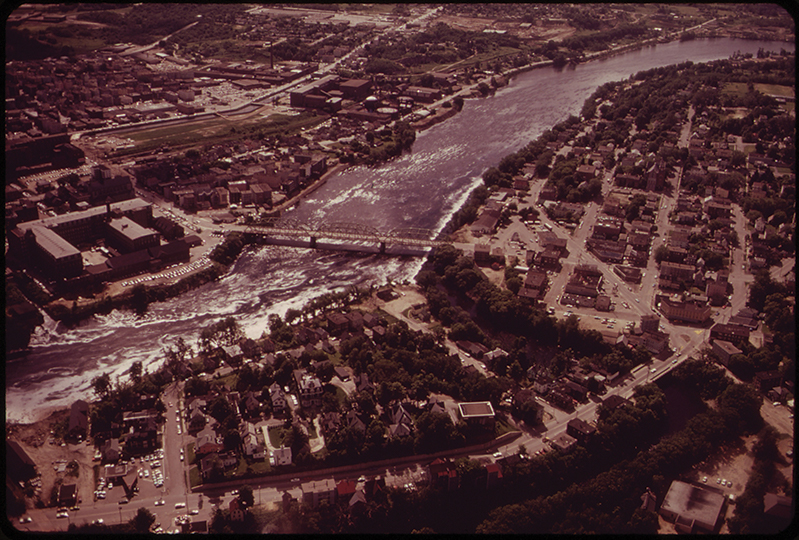
The view above in 1973, one year after the Clean Water Act.
PHOTO: CHARLES STEINHACKER
Water bodies across the state now face new challenges. The next 50 years of water quality is tied to the state of wastewater treatment capacity. Wastewater treatment facilities—which didn’t exist before the Clean Water Act, and since its passage have played a substantial role in cleaning up Maine’s waters—now pose a threat of their own.
The treatment plants process water that contains nitrogen and phosphorus from human waste, food, and certain soaps and detergents. Around 34 billion gallons of wastewater move through America’s plants each day, and once the water is cleaned to the standards set and monitored by state and federal officials, it is typically released into some local body of water. The Clean Water Act authorized federal funding for the construction of municipal sewage treatment plants, with money distributed to cities and towns so that they could better comply with the new water quality expectations.
But some of the plants are able to remove these chemicals better than others, so the processing isn’t always done to completion and this discharge can and does become a source of chemical pollution.
Photographer Charles Steinhacker was hired by the Environmental Protection Agency as part of its Documerica Project. The goal was to capture images of environmental problems in the United States. This series of images from 1973 depicts the pollution entering the Androscoggin River.
Elimination System (NPDES), polluters today are in consent agreements with EPA. NPDES permits are licenses that allow facilities to dump up to a certain amount of a pollutant into a water body. Permits may also authorize facilities to process, incinerate, or make use of sewage sludge.
Just this year, residents in Fairfield learned that high levels of PFAS chemical compounds have been leaching into their groundwater for decades; wells, streams, and even soil were revealed to be dangerously contaminated. These “forever chemicals,” which are widely used and don’t naturally break down, settle in the sludge at the bottom of wastewater treatment plants.
Under NPDES oversight, the sludge is sometimes used as a soil fertilizer and spread over agricultural fields. According to the Maine Department of Environmental Protection, the sludge in Fairfield came from the Kennebec Sanitary Treatment District, which was collecting industrial waste from the Huhtamaki paper packaging mill in Waterville. However, DEP officials say that the company was well within its right to spread it and in compliance with state permits.
Many treatment plants in Maine are fed by old piping—some are made of clay and date back over a hundred years—which can allow other pollutants to leach through. Peter Didisheim, senior director of advocacy for the Natural Resources Council of Maine, says there’s been about a $1 billion backlog in funding from the state that should be going towards upgrade, a delay made more dangerous with time as increased storm activity and rising tides threaten Maine’s many treatment plants that sit at sea level.
Extreme weather events can overwhelm a plant and discharge polluted, untreated water. It’s likely that some of these plants will either have to be rebuilt or moved.
“Several of the dischargers, like Portland and Bangor right now, are under consent agreements with the EPA that they’re in violation of the Clean Water Act,” explained Didisheim.
But they’re in an impossible situation. Where’s the money going to come from to address the deficiencies in their system?
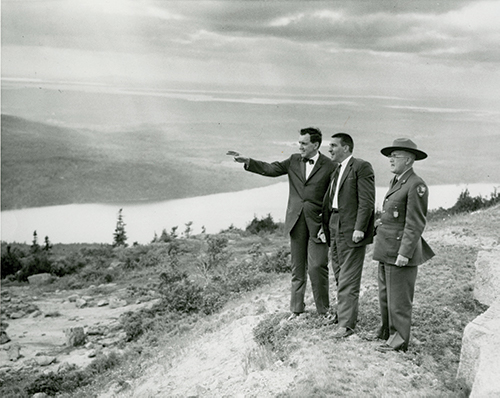
Maine Senator Edmund S. Muskie, left, with Secretary of the Interior Stewart Udall and an unidentified National Park Service employee at Cadillac Mountain in Acadia National Park in 1962.
Funding helps when it can be secured—2018 saw a $12 million upgrade to the 36-year-old aeration system at the East End Wastewater Treatment Facility in Portland. Modernizing the system meant the plant could continue to do its job during dramatic weather events, and it recently stood up to one of the wettest Octobers Maine has ever had.
In the last four years, the East End facility has reduced its nitrogen output by about 1.5 million pounds.
Casco Bay Waterkeeper Ivy Frignoca is also concerned about the impact of rising sea level on old treatment plants, and thinks the Clean Water Act should be modified so that it is more forward thinking.
“When the regulations were written to implement the Clean Water Act, we weren’t thinking about climate change. Everything was decided based on the science that was known then,” said Frignoca. “Now we have to be thinking about the fact that our waters aren’t just warmer than a decade ago, they’re going to continue to warm.”
Federal infrastructure money from the Build Back Better effort and the American Rescue Plan will be helpful. Frignoca is also hopeful that the Maine Won’t Wait climate action plan, which calls for updating many of the current coastal land use regulations, will provide support from a more local level.
“All of this is quite exciting to those of us who have been eager to achieve the original goal of the Clean Water Act, which is to eliminate altogether the discharge of pollutants into our rivers, streams, and coastal waters,” said Didisheim.
The time for a more hardline approach to pollution regulation might be upon us as we enter into an ever-changing situation with our climate. Just as it was in Muskie’s day, harm to water is invisible until it’s too late. If we don’t act soon, we might end up walking around again with clothespins on our noses.

